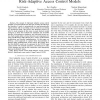96 search results - page 3 / 20 » The role of secondary attributes in formal object modelling |
CCECE
2006
IEEE
14 years 3 months ago
2006
IEEE
Recent experimental evidences have shown that ribonucleic acid (RNA) plays a greater role in the cell than previously thought. An ensemble of RNA sequences believed to contain sig...
ICCS
2007
Springer
14 years 3 months ago
2007
Springer
Abstract. Frames, i.e., recursive attribute-value structures, are a general format for the decomposition of lexical concepts. Attributes assign unique values to objects and thus de...
ACSAC
2008
IEEE
14 years 3 months ago
2008
IEEE
Role hierarchies are fundamental to the role based access control (RBAC) model. The notion of role hierarchy is a well understood concept that allows senior roles to inherit the p...
ARESEC
2011
12 years 9 months ago
2011
—The concept of risk-based adaptive access control (RAdAC, pronounced Raid-ack) has been recently introduced in the literature. It seeks to automatically (or semi-automatically) ...
ECOOP
2009
Springer
14 years 9 months ago
2009
Springer
Role-based access control (RBAC) is a common paradigm to ensure that users have sufficient rights to perform various system operations. In many cases though, traditional RBAC does ...

